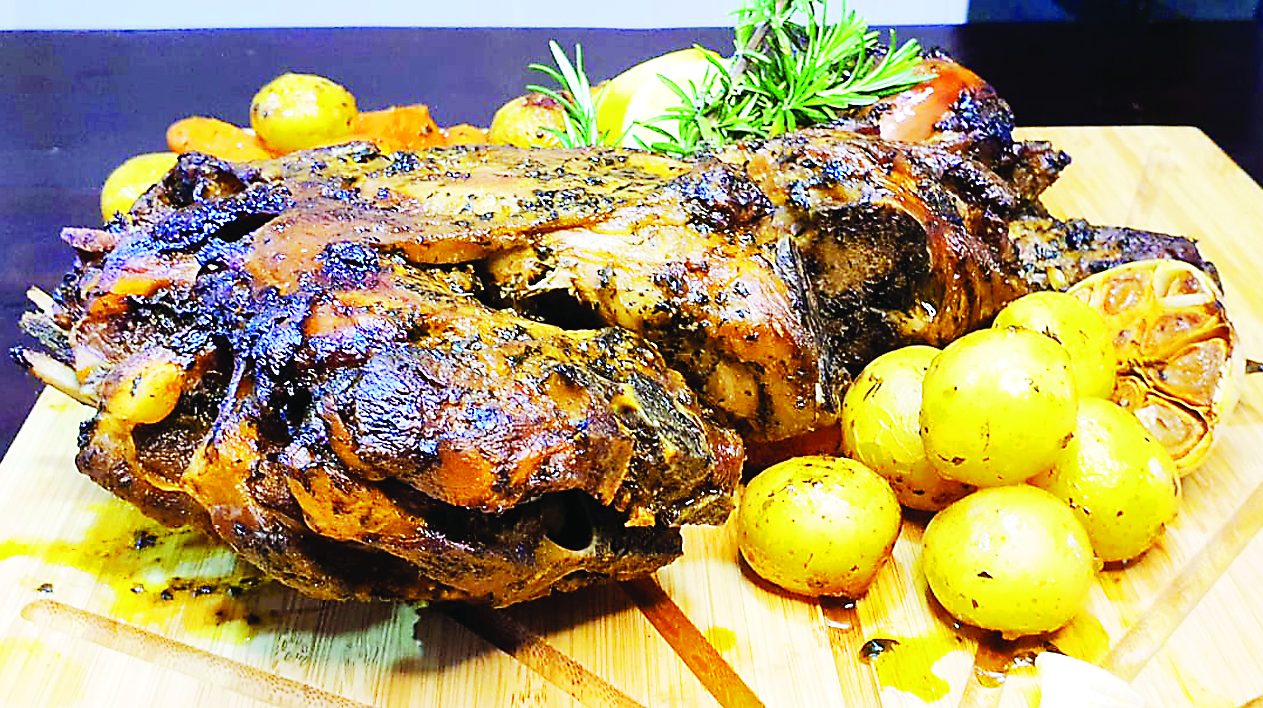
Lifestyle

Relying on food to get through this New Year
Rosh Hashanah is usually a time of delicious food shared with precious loved ones and friends, but this year we need to rely on just the tasty treats to get us through this New Year. Sharon Lurie and Lauren Boolkin have given you some delectable foodie options.
SHARON LURIE
Rookie sushi salad
I’m not embarrassed to admit that I battle to make sushi rice: mine always turns out sticky-gritty-mashed something or anything unassociated with the wonderful world of this Japanese cuisine. That was until my granddaughter said: “Bobba, use brown rice, it’s just as good” and she was quite right. Her recipe included a layer of rice on the serving platter, topped with sections of smoked salmon/trout, chopped cucumber, coriander and radish, and sesame seeds. This recipe, however, gives you the opportunity to include other vegetables.
One thing we did agree on was that ready-fried onions (available at many kosher supermarkets) have to be piled, really high, on top of the salad.
Ingredients
3 cups ready-cooked brown short grain rice
1 English cucumber, cut in half, pips removed, and chopped/julienned/sliced on the diagonal
2-3 sticks of celery, finely sliced on the diagonal
250g baby mealies, sliced/chopped (you can use two cups of corn, defrosted)
250g sugar snap peas, sliced in thirds on the diagonal
1 red pepper, deseeded and thinly sliced/chopped
1 green pepper, deseeded and thinly sliced/chopped
1 yellow pepper, deseeded and thinly sliced/chopped
2 carrots, julienned/finely chopped
8-10 sliced/chopped red radishes
½ cup chopped spring onions
100-200g smoked salmon/trout bits
2 avocados – sliced/cubed when ready to serve
100g salted cashew nuts
1 packet dry crushed ramen noodles (optional, but different textures make a salad special!)
Handful of chopped fresh coriander for garnishing
Fried onion rings
½ cup sesame seeds (dry-fried or baked to bring out the flavour and crisp up)
Method
Cook rice as per instructions on the packet.
Allow to cool and place on a serving platter.
Place selected vegetables on top of the rice in rows so that you section off the vegetables. (sliced or chopped depending on how you want your salad to look – I prefer chopped.)
Pour over salad dressing just before serving and finally sprinkle generously with fried onions and sesame seeds.
Dressing
¼ cup soy sauce
¼ cup lemon juice
¼ cup orange juice
2 tbsp honey
1 tbsp finely grated ginger
¼ cup rice vinegar
¼ cup sesame oil
½ cup sunflower oil
1-2 teaspoons chilli flakes (depending on how spicy you like your food)
Plus sachet of powdered stock from noodles if you are using noodles.
If not, add two teaspoons of powdered vegetable stock.
Method
Shake up all dressing ingredients in a jar with a secure-fitting lid.
When ready to serve, pour the dressing over the salad and garnish with the coriander and cashew nuts, and crumble the optional noodles (crushed in your hand) over the top of the dressed salad.
Finally, sprinkle with fried onion rings.
Serves 8–10
Sriracha and honey chicken
Although Sriracha sauce is quite spicy and one should symbolically eat sweeter dishes over Rosh Hashanah, the honey in this dish does that without making it too sweet.
The glaze on the chicken should be quite dark and sticky with a Thai-flavoured twist. Serve with jasmine rice and peas.
Ingredients
1 chicken braai pack cut into 10 pieces
Little oil for frying
3 cloves garlic
⅓ cup honey
⅓ cup Sriracha chilli sauce
2 tbsp soy sauce
2 tsp rice vinegar or apple cider
3 tbsp sesame oil
Fresh coriander and sesame seeds for decorating
Method
Preheat oven to 170 degrees celcius.
Blend garlic, honey, Sriracha, soy sauce, vinegar, and sesame oil until smooth.
Fry or braai (BBQ) chicken pieces until golden brown.
Place chicken pieces side by side in a single layer in an ovenproof baking dish — not too large or the lovey glaze will evaporate too quickly. Cover with sauce and tinfoil.
Cook for 45 mins to one hour or until cooked through. Remember the chicken is cut into portions so it will cook a little quicker than a whole chicken.
Remove tinfoil and, if the glaze isn’t a lightish brown, then allow the glaze to brown up a little.
Sprinkle with sesame seeds and fresh coriander.
Fruit compôte brȗlée
Ingredients
500g mixed dried fruit, including raisins
4 cups of your favourite fruit juice or juices e.g. mixed berry, grape, apple, cranberry, etc.
1 tsp finely grated fresh ginger
1 tsp vanilla
1 tsp cinnamon
1½ tbsp custard powder dissolved in one cup juice set aside earlier
1 packet vanilla instant pudding
Coconut milk (enough for pudding) — follow instructions on package of pudding using coconut milk instead of milk or water
Brown sugar, enough to cover the ramekin dishes of fruit
Method
Place dried fruit, ginger, vanilla, and cinnamon in a medium-sized saucepan.
Cover with three cups fruit juice, keeping one cup aside for later.
Bring fruit and juice to the boil with lid on.
As it starts to boil, reduce heat and allow the fruit to simmer, covered, for 15-20 minutes until the fruit is soft.
Dissolve custard powder in the cup of juice set aside earlier, and slowly add to fruit while it’s simmering. Keep stirring carefully as you add the custard juice so that it doesn’t get lumpy.
Allow fruit to continue simmering over low heat for another 10 minutes until it thickens.
Remove from heat and allow to cool then refrigerate.
Beat instant pudding with coconut milk until firm.
Remove fruit from the fridge and place in small ramekin dishes or in a single ovenproof dish.
Cover with a layer of firm vanilla instant pudding, about 1-2 cm.
Top with: A generous sprinkling of brown sugar, then caramelize it under the grill on the top shelf, watching all the time to ensure it doesn’t burn. Or you can use a blow torch, carefully!
LAUREN BOOLKIN
Kreplach soup
Kreplach have been around since medieval times. They originated in Eastern Europe, and can be filled with meat, chicken, or cheese. They are traditionally eaten at the start of the Yom Kippur fast, on the seventh day of Sukkot, and on Purim.
Don’t be nervous to make them. Start by making your dough thicker, and as you get better at them, roll your dough thinner and thinner. If you are lucky enough to access wonton wrappers, you’ll have your kreplach done in a jiffy.
Ingredients
2 jumbo eggs
1¼ cup flour
¼ tsp salt
100g mincemeat flavoured with 1½ tsp chopped onion, ¼ tsp salt, and a pinch of pepper
Method
Place the sifted cake flour in a bowl, and add the salt. Stir in the lightly beaten eggs, and mix with a fork until a dough forms. Roll the dough into a ball, and rest it covered with plastic wrap for 30 minutes. Flour the board or countertop and your rolling pin well, and roll the dough out as thin as you can get it. Make sure the board is well floured underneath. Using a sharp knife, cut the dough into squares 7cm by 7cm.
Place a small blob of meat in the centre of each square. (Tip: don’t put meat into all your squares until you have the hang of the folding.)
Form into triangles by bringing the two sides together, and then the bottom up. (Shape into half moons if this is going to put you off making the kreplach!)
Flash freeze these for an hour uncovered, and then put into a Ziploc ready to pop into the boiling soup. When you cook the kreplach, make sure your soup is boiling. They are ready when they float up to the top of the pot.
Pavlova Grazing Board
This must be the most spectacular, simplest dessert ever invented. A special fellow foodie WhatsApped me a picture of a pavlova grazing board, and I’m now obsessed. The PGB went viral when Shalini Nestor posted a photo on her Swish Biscuits Instagram towards the end of last year. Feel free to put whatever your family loves on the board. I have included a pavlova recipe, but honestly, the bakeries in Joburg have gorgeous readymade ones. Similarly, Staffords makes a perfect bottled lemon curd which is kosher and parev.
Mini pavlovas
12 egg whites at room temperature
660g castor sugar
Preheat your oven to 120 degrees. Place the egg whites into a very clean bowl. Beat until frothy, then gradually add the sugar. Beat until the meringue is thick.
Using a spoon, plop the meringue onto a paper-lined baking sheet in rounds. It helps to draw the rounds with a pencil and teacup (the teacup for sizing), but make sure the leaded side is on the underside. Using a spatula, make peaks up the sides. Bake for 1½ hours, and then switch off the oven and allow them to cool.
Suggested ingredients
Lemon curd
Pomegranate seeds
Cherries
Blueberries
Strawberries
Granadilla pulp
Chocolates
Honeycomb
Lisianthas and roses to decorate
Fenugreeked lamb shoulder for Rosh Hashanah
Fenugreek is one of the earliest traditional foods of Rosh Hashanah. It’s a plant indigenous to Southeast Asia and the Middle East. I have included some carrots as these, too, are a symbolic food eaten on Rosh Hashanah. The baby potatoes are there because they are delicious! The lamb is best marinated the day before cooking. It freezes well, and can be made the day before, sliced, and warmed. Start early, as it cooks for a long time.
Ingredients
1 lamb shoulder
2 lemons
4 garlic cloves
1 tbsp paprika
1 tsp cumin seeds
½ tsp fenugreek seeds
1 pkt mint leaves
1 pkt coriander
4 tbsp olive oil
4 carrots peeled and thickly sliced
1 head of garlic cut in half horizontally (don’t worry, you’re wearing a mask)
Salt and pepper
Method
In a dry pan, toast the fenugreek and cumin until fragrant. Grind in a pestle and mortar. Zest the lemons, and place them in a food processor with the ground spices. Squeeze the lemons, and add the juice to the processor with the olive oil, fresh herbs, garlic, salt, and pepper. Grind these all together to make a paste.
Massage the paste into your washed and dried meat making sure to get into all the crevices. I like to stab the meat a bit with a sharp knife before spicing! Marinate overnight.
Preheat your oven to 180 degrees, and place the lamb into the oven covered. Baste every hour. After two hours, add the carrots, garlic head, and potatoes, and reduce the temperature to 160 degrees. Continue cooking the meat for another two hours, uncovering your dish for the last half hour. If there is insufficient gravy to baste, add one beef cube dissolved in a cup of boiling water, but I rarely need to do this. Serve surrounded by the vegetables garnished with lemons and rosemary.










